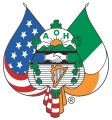Shamrock

Ashamrockis a type ofclover,used as a symbol ofIreland.Saint Patrick,one of Ireland's patron saints, is said to haveused itas a metaphor for the ChristianHoly Trinity.[1]The nameshamrockcomes fromIrishseamróg([ˈʃamˠɾˠoːɡ]), which is thediminutiveof the Irish wordseamairand simply means "young clover".[2]
At most times,Shamrockrefers to either the speciesTrifolium dubium(lesser/yellow clover, Irish:seamair bhuí)[3]orTrifolium repens(white clover, Irish:seamair bhán). However, otherthree-leavedplants—such asMedicago lupulina,Trifolium pratense,andOxalis acetosella—are sometimes called shamrocks. The shamrock was traditionally used for itsmedicinalproperties,[4]and was a popularmotifinVictoriantimes.
Botanical species
[edit]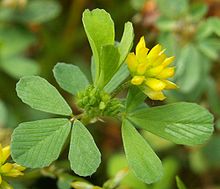
There is still not a consensus over the precisebotanicalspecies of clover that is the "true" shamrock.John Gerardin his herbal of 1597 defined the shamrock asTrifolium pratenseorTrifolium pratense flore albo,meaning red or white clover. He described the plant in English as "Three leaved grasse" or "Medow Trefoile", "which are called in IrishShamrockes".[5]The Irish botanistCaleb Threlkeld,writing in 1726 in his work entitledSynopsis Stirpium HibernicarumorA Treatise on Native Irish Plantsfollowed Gerard in identifying the shamrock asTrifolium pratense,calling it White Field Clover.[6]
The botanistCarl Linnaeusin his 1737 workFlora Lapponicaidentifies the shamrock asTrifolium pratense,mentioning it by name asChambroch,with the following curious remark: "Hiberni suo Chambroch, quod est Trifolium pratense purpureum, aluntur, celeres & promtissimi roburis"('The Irish call it shamrock, which is purple field clover, and which they eat to make them speedy and of nimble strength').[7][8]

Linnaeus based his information that the Irish ate shamrock on the comments of English Elizabethan authors such asEdmund Spenserwho remarked that the shamrock used to be eaten by the Irish, especially in times of hardship and famine. It has since been argued however, that the Elizabethans were confused by the similarity between the Irish (Gaelic) name for young cloverseamróg,and the name forwood sorrelseamsóg.[9]
The situation regarding the identity of the shamrock was further confused by a London botanistJames Ebenezer Bicheno,who proclaimed in a dissertation in 1830 that the real shamrock wasOxalis acetosella,a species of wood sorrel.[10]Bichino falsely claimed that clover was not a native Irish plant and had only been introduced into Ireland in the middle of the 17th century, and based his argument on the same comments by Elizabethan authors that shamrock had been eaten. Bicheno argued that this fitted the wood sorrel better than clover, as wood sorrel was often eaten as a green and used to flavour food. Bicheno's argument has not been generally accepted however, as the weight of evidence favours a species of clover.
A more scientific approach was taken by English botanistsJames Brittenand Robert Holland, who stated in theirDictionary of English Plant Namespublished in 1878, that their investigations had revealed thatTrifolium dubiumwas the species sold most frequently inCovent Gardenas shamrock onSt. Patrick's Day,and that it was worn in at least 13 counties in Ireland.[11]

Finally, detailed investigations to settle the matter were carried out in two separate botanical surveys in Ireland, one in 1893[12][13]and the other in 1988.[14]The 1893 survey was carried out byNathaniel Colgan,an amateur naturalist working as a clerk inDublin;while the 1988 survey was carried out byE. Charles Nelson,Director of theIrish National Botanic Gardens.Both surveys involved asking people from all across Ireland to send in examples of shamrock, which were then planted and allowed to flower, so that their botanical species could be identified. The results of both surveys were very similar, showing that the conception of the shamrock in Ireland had changed little in almost a hundred years. The results of the surveys are shown in the table below.

| Botanical name | Common name | Percentage | |
|---|---|---|---|
| 1893 | 1988 | ||
| Trifolium dubium | Lesser clover | 51% | 46% |
| Trifolium repens | White clover | 34% | 35% |
| Trifolium pratense | Red clover | 6% | 4% |
| Medicago lupulina | Black medick | 6% | 7% |
| Oxalis acetosella | Wood sorrel | _ | 3% |
| VariousTrifoliumspp.,Oxalisspp. | 3% | 5% | |
The results show that there is no one "true" species of shamrock, but thatTrifolium dubium(lesser clover) is considered to be the shamrock by roughly half of Irish people, andTrifolium repens(white clover) by another third, with the remaining sixth split betweenTrifolium pratense(red clover),Medicago lupulina(black medick),Oxalis acetosella(wood sorrel), and various other species ofTrifoliumandOxalis.None of the species in the survey are unique to Ireland, and all are common European species, so there is no botanical basis for the belief that the shamrock is a unique species of plant that only grows in Ireland.
Early references
[edit]The word shamrock derives fromseamair ógor young clover, and references tosemairor clover appear in early Irish literature, generally as a description of a flowering clovered plain. For example, in the series of medieval metrical poems about various Irish places called theMetrical Dindshenchus,a poem aboutTailtiuorTeltownin County Meath describes it as a plain blossoming with flowering clover (mag scothach scothshemrach).[15]Similarly, another story tells of howSt. Brigiddecided to stay in County Kildare when she saw the delightful plain covered in clover blossom (scoth-shemrach).[16]However, the literature in Irish makes no distinction between clover and shamrock, and it is only in English that shamrock emerges as a distinct word.
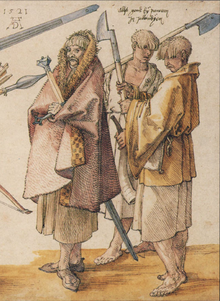
The first mention of shamrock in the English language occurs in 1571 in the work of the English Elizabethan scholarEdmund Campion.In his workBoke of the Histories of Irelande,Campion describes the habits of the "wild Irish" and states that the Irish ate shamrock: "Shamrotes, watercresses, rootes, and other herbes they feed upon".[17]The statement that the Irish ate shamrock was widely repeated in later works and seems to be a confusion with the Irish wordseamsógorwood sorrel(Oxalis).[9]There is no evidence from any Irish source that the Irish ate clover, but there is evidence that the Irish ate wood sorrel. For example, in the medieval Irish workBuile Shuibhne(The Frenzy of Sweeney), the king Sweeney, who has gone mad and is living in the woods as a hermit, lists wood sorrel among the plants he feeds upon.[18]
The English Elizabethan poetEdmund Spenser,writing soon after in 1596, described his observations of war-torn Munster after theDesmond Rebellionin his workA View of the Present State of Ireland.Here shamrock is described as a food eaten as a last resort by starving people desperate for any nourishment during a post-war famine:
Anatomies of death, they spake like ghosts, crying out of theire graves; they did eat of the carrions.... and if they found a plott of water cresses or shamrockes theyr they flocked as to a feast for the time, yett not able long to contynewe therewithall.[19]
The idea that the Irish ate shamrock is repeated in the writing ofFynes Moryson,one-time secretary to theLord Deputy of Ireland.In his 1617 workAn itinerary thorow Twelve Dominions,Moryson describes the "wild Irish", and in this case their supposed habit of eating shamrock is a result of their marginal hand-to-mouth existence as bandits. Moryson claims that the Irish "willingly eat the herbe Schamrock being of a sharpe taste which as they run and are chased to and fro they snatch like beasts out of the ditches." The reference to a sharp taste is suggestive of the bitter taste of wood sorrel.[20]
What is clear is that by the end of the sixteenth century the shamrock had become known to English writers as a plant particularly associated with the Irish, but only with a confused notion that the shamrock was a plant eaten by them. To a herbalist like Gerard it is clear that the shamrock is clover, but other English writers do not appear to know the botanical identity of the shamrock. This is not surprising, as they probably received their information at second or third hand. It is notable that there is no mention anywhere in these writings of St. Patrick or the legend of his using the shamrock to explain the Holy Trinity. However, there are two possible references to the custom of "drowning the shamrock" in "usquebagh" orwhiskey.In 1607, the playwrightEdward Sharphamin his playThe Fleireincluded a reference to "Maister Oscabath the Irishman... and Maister Shamrough his lackey".[21]Later, a 1630 work entitledSir Gregory Nonsenceby the poetJohn Taylorcontains the lines: "Whilste all the Hibernian Kernes in multitudes, /Did feast with shamerags steeved in Usquebagh."[22]
Link to St. Patrick
[edit]
Traditionally, shamrock is said to have been used bySaint Patrickto illustrate the Christian doctrine of theHoly TrinitywhenChristianisingIreland in the 5th century. The first evidence of a link between St Patrick and the shamrock appears in 1675 on the St Patrick's Coppers or Halpennies. These appear to show a figure of St Patrick preaching to a crowd while holding a shamrock,[23]presumably to explain the doctrine of the Holy Trinity.[24]When Saint Patrick arrived in Ireland in 431, he used the shamrock to teach pagans the Holy Trinity. In pagan Ireland, three was a significant number and the Irish had manytriple deities,which could have aided St Patrick in hisevangelisationefforts.[24][25]Patricia Monaghanstates that "There is no evidence that the clover or wood sorrel (both of which are called shamrocks) were sacred to the Celts". However,Jack Santinospeculates that "The shamrock was probably associated with the earth and assumed by the druids to be symbolic of the regenerative powers of nature... Nevertheless, the shamrock, whatever its history as a folk symbol, today has its meaning in a Christian context. Pictures of Saint Patrick depict him driving the snakes out of Ireland with acrossin one hand and a sprig of shamrocks in the other. "[26]Roger Homan writes, "We can perhaps see St Patrick drawing upon the visual concept of thetriskelewhen he uses the shamrock to explain the Trinity ".[27]Why the Celts to whom St Patrick was preaching would have needed an explanation of the concept of a triple deity is not clear, since at least two separatetriple goddessesare known to have been worshipped in pagan Ireland -Ériu,FódlaandBanba;andBadb Catha,MachaandThe Morrígan.
The first written mention of the link does not appear until 1681, in the account of Thomas Dineley, an English traveller to Ireland. Dineley writes:
The 17th day of March yeerly is St Patricks, an immoveable feast, when ye Irish of all stations and condicions were crosses in their hatts, some of pinns, some of green ribbon, and the vulgar superstitiously wear shamroges, 3 leav'd grass, which they likewise eat (they say) to cause a sweet breath.[28]
There is nothing in Dineley's account of the legend of St. Patrick using the shamrock to teach the mystery of the Holy Trinity, and this story does not appear in writing anywhere until a 1726 work by the botanistCaleb Threlkeld.[6]Threlkeld identifies the shamrock as White Field Clover (Trifolium pratense album) and comments rather acerbically on St. Patrick's Day customs including the wearing of shamrocks:
This plant is worn by the people in their hats upon the 17. Day of March yearly, (which is called St. Patrick's Day.) It being a current tradition, that by this Three Leafed Grass, he emblematically set forth to them the Mystery of the Holy Trinity. However that be, when they wet their Seamar-oge, they often commit excess in liquor, which is not a right keeping of a day to the Lord; error generally leading to debauchery.
The Rev Threlkeld's remarks on liquor undoubtedly refer to the custom of toasting St. Patrick's memory with "St. Patrick's Pot", or "drowning the shamrock" as it is otherwise known. After mass on St. Patrick's Day the traditional custom of the menfolk was to lift the usual fasting restrictions ofLentand repair to the nearest tavern to mark the occasion with as many St. Patrick's Pots as they deemed necessary. The drowning of the shamrock was accompanied by a certain amount of ritual as one account explains:[29][30]

"The drowning of the shamrock" by no means implies it was necessary to get drunk in doing so. At the end of the day the shamrock which has been worn in the coat or the hat is removed and put into the final glass of grog or tumbler of punch; and when the health has been drunk or the toast honoured, the shamrock should be picked out from the bottom of the glass and thrown over the left shoulder.
The shamrock is still chiefly associated withSaint Patrick's Day,which has become the Irish national holiday, and is observed with parades and celebrations worldwide. The custom of wearing shamrock on the day is still observed and depictions of shamrocks are habitually seen during the celebrations.
Symbol of Ireland
[edit]
As St. Patrick is Ireland's patron saint, the shamrock has been used as a symbol of Ireland since the 18th century. The shamrock first began to evolve from a symbol purely associated with St. Patrick to an Irish national symbol when it was taken up as anemblemby rival militias during the turbulent politics of the late eighteenth century. On one side were the Volunteers (also known as theIrish Volunteers), who were local militias in late 18th centuryIreland,raised to defend Ireland from the threat of French and Spanish invasion when regular British soldiers were withdrawn from Ireland to fight during theAmerican Revolutionary War.[31]On the other side were revolutionary nationalist groups, such as theUnited Irishmen.
Among the Volunteers, examples of the use of the shamrock include its appearance on the guidon of the Royal Glin Hussars formed in July 1779 by theKnight of Glin,and its appearance on the flags of the Limerick Volunteers, the Castle Ray Fencibles and the Braid Volunteers.[32][33]The United Irishmen adopted green as their revolutionary colour and wore green uniforms or ribbons in their hats, and the green concerned was often associated with the shamrock. The songThe Wearing of the Greencommemorated their exploits and various versions exist which mention the shamrock. TheErin go braghflag was used as their standard and was often depicted accompanied by shamrocks, and in 1799 a revolutionary journal entitledThe Shamrocbriefly appeared in which the aims of the rebellion were supported.[34]

Since the1800 Acts of Unionbetween Britain and Ireland the shamrock was incorporated into theRoyal Coat of Arms of the United Kingdom,depicted growing from a single stem alongside the rose of England, and thethistleof Scotland to symbolise the unity of the three kingdoms. Since then, the shamrock has regularly appeared alongside the rose, thistle and (sometimes)leekfor Wales inBritish coinssuch as the two shilling and crown, and instamps.The rose, thistle and shamrock motif also appears regularly on British public buildings such asBuckingham Palace.
Throughout the nineteenth century the popularity of the shamrock as a symbol of Ireland grew, and it was depicted in many illustrations on items such as book covers and St. Patrick's Day postcards. It was also mentioned in many songs and ballads of the time. For example, a popular ballad calledThe Shamrock Shorelamented the state of Ireland in the nineteenth century.[35]Another typical example of such a ballad appears in the works ofThomas MoorewhoseOh the Shamrockembodies the Victorian spirit of sentimentality. It was immensely popular and contributed to raising the profile of the shamrock as an image of Ireland:[36]
Oh The Shamrock
-
Through Erin's Isle,
To sport awhile,
As Love and Valor wander'd
With Wit, the sprite,
Whose quiver bright
A thousand arrows squander'd.
Where'er they pass,
A triple grass
Shoots up, with dew-drops streaming,
As softly green
As emeralds seen
Through purest crystal gleaming.
Oh the Shamrock, the green immortal Shamrock!
Chosen leaf
Of Bard and Chief,
Old Erin's native Shamrock!

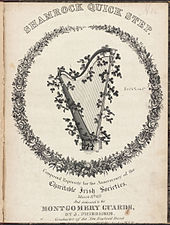

Throughout the nineteenth and twentieth centuries, the shamrock continued to appear in a variety of settings.[37]For example, the shamrock appeared on many buildings in Ireland as a decorative motif, such as on the facade of theKildare Street Clubbuilding in Dublin,St. Patrick's Cathedral, Armagh,and the Harp and Lion Bar inListowel,County Kerry. It also appears on street furniture, such as old lamp standards like those inMountjoy Squarein Dublin, and on monuments like theParnellMonument, and theO'Connell Monument,both inO'Connell Street,Dublin. Shamrocks also appeared on decorative items such as glass, china, jewellery,poplinandIrish lace.Belleek Potteryin County Fermanagh, for example, regularly features shamrock motifs.
-
Lamppost inMountjoy Square,Dublin, early 20th century
-
Design on Harp and Lion Bar,Listowel,County Kerry
-
Work byBelleek Pottery,which often features shamrock motifs
-
2dMap ofIreland:the first Irish postage stamp featured the shamrock.
-
Shamrock on the tail fin of anAirbus A321neoofAer Lingus
The shamrock is used in the emblems of many state organisations, both in theRepublic of IrelandandNorthern Ireland.Some of these are all-Ireland bodies, (such asTourism Ireland)[38]as well as organisations specific to theRepublic of Ireland(such asIDA Ireland)[39]andNorthern Ireland(such asPolice Service of Northern Ireland). The Irish Postal ServiceAn Post,regularly features the shamrock on itsseries of stamps.The airlineAer Lingususes the emblem in its logos, and itsair traffic controlcall signis "SHAMROCK".
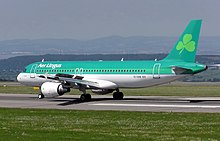
The shamrock has been registered as a trademark by theGovernment of Ireland.[40][41]In the early 1980s, Ireland defended its right to use the shamrock as its national symbol in a German trademark case, which included high-level representation fromTaoiseachCharles Haughey.Having originally lost, Ireland won on appeal to the German Supreme Court in 1985.[42]
Since 1969, a bowl of shamrocks in a specialWaterford Crystalbowl featuring a shamrock design is flown from Ireland toWashington, D.C.,and presented to the President of the United States every St. Patrick's Day.[43]
Shamrock is also used in emblems of UK organisations with an association with Ireland, such as theIrish Guards.Soldiers of theRoyal Irish Regimentof theBritish Armyuse the shamrock as their emblem, and wear a sprig of shamrock onSaint Patrick's Day.Shamrock are exported to wherever the regiment is stationed throughout the world.Queen Victoriadecreed over a hundred years ago that soldiers from Ireland should wear a sprig of shamrock in recognition of fellow Irish soldiers who had fought bravely in theBoer War,a tradition continued by British army soldiers from both the north and the south of Ireland followingpartitionin 1921. The coat of arms on the flag of theRoyal Ulster ConstabularyGeorge Cross Foundation was cradled in a wreath of shamrock.[44]
The shamrock also appears in the emblems of a wide range of voluntary and non-state organisations in Ireland, such as theIrish Farmers Association,[45]the Boy Scouts of Ireland association,Scouting Ireland[46]Irish Girl Guides,[47]and the Irish Kidney Donors Association.[48]In addition many sporting organisations representing Ireland use the shamrock in their logos and emblems. Examples include theIrish Football Association(Northern Ireland),Irish Rugby Football Union,Swim Ireland,Cricket Ireland,and theOlympic Council of Ireland.A sprig of shamrock represents theLough Derg Yacht ClubTipperary, (est. 1835). The shamrock is the official emblem of Irish football clubShamrock Rovers.
-
Flag of the Irish Rugby Football Union
-
Flag of Cricket Ireland
-
Ensign of the Lough Derg Yacht Club
-
Ensign of the Royal North of Ireland Yacht Club
-
Ensign of the Royal Western Yacht Club of Ireland
-
House flag of Irish Continental Line (1978–1988)
-
House flag of the Lord Line (Irish Shipowners Company)
Use outside Ireland
[edit]Shamrock commonly appear as part of the emblem of many organisations in countries overseas with communities of Irish descent. Outside Ireland, various organisations, businesses and places also use the symbol to advertise a connection with the island. These uses include:
- The shamrock features in the emblem of theAncient Order of Hibernians,the largest and oldest Irish Catholic organisation. Founded in New York City in 1836 by Irish immigrants, it claims a membership of 80,000 in the United States, Canada and Ireland.[49]
- TheEmerald Society,an organisation of American police officers or fire fighters of Irish heritage, includes a shamrock on its badge. Emerald Societies are found in most major US cities such as New York City, Milwaukee, Jersey City, Washington, Boston, Chicago, San Francisco, Los Angeles and Saint Paul, Minnesota.
- The shamrock is featured in the "compartment" of the RoyalArms of Canada,as part of a wreath of shamrocks, roses, thistles, and lilies (representing the Irish, English, Scottish, and French settlers of Canada).
- Theflagof the city ofMontreal,Quebec, Canada has a shamrock in the lower right quadrant. The shamrock represents the Irish population, one of the four major ethnic groups that made up the population of the city in the 19th century when the arms were designed, the other three being the French (represented by afleur-de-lisin the upper-left), the English (represented by a rose in the upper-right), and the Scots (represented by a thistle in the lower-left).
- The shamrock is featured on the passport stamp ofMontserrat,many of whose citizens are of Irish descent.
- The shamrock signified theSecond Corpsof theArmy of the Potomacin theAmerican Civil War,which contained theIrish Brigade.It can still be seen on the regimental coat of arms of "The Fighting Sixty-Ninth"
- TheErin Go Braghflag, used originally by theSaint Patrick's Battalionof theMexican Army,uses an angelicCláirseach,a medieval Irishharp,cradled in a wreath of clover.[citation needed]
- The crest ofGlasgow Celtic Football Cluboriginally included a shamrock which was changed in 1938 to afour leaved cloverfor reasons that remain unclear.[50]The club was founded in 1887 in Glasgow among the poor Irish immigrants of the city.
- London Irishrugby football club has a shamrock on its crest. The club was founded in 1898 for the young Irishmen of London.
- The Shamrocks Motorcycle Club is a US-based traditionalmotorcycle club(composed of law enforcement personnel) which uses the shamrock as its name and symbol.[51]
- The basketball team,Boston Celtics,in the USA incorporate the shamrock in their logo. Former NBA playerShaquille O'Nealnicknamed himself the "Big Shamrock" after joining the team.
- In Australia, theMelbourne Celtic Clubfeatures a shamrock on its emblem. The club was founded in 1887 for the Irish and other Celtic groups in the city.[52]
- During theRussian Civil Wara British officer Col.P.J. Woods,of Belfast, established aKarelian Regimentwhich had a shamrock on an orange field as its regimental badge.
- A shamrock (Trifylli) is the official emblem of Greek multi-sport clubPanathinaikos A.O.,Greek football clubAcharnaikos F.C.and Cypriot sports clubAC Omonia.A red shamrock is also the emblem ofPlatanias F.C.,a Cretan football team ofChania.
- The Danish football clubViborg FFuses a shamrock in its badge and it has become a symbol of the town ofViborg.
- The German football clubSpVgg Greuther Fürthalso has a shamrock in its badge as it is a symbol of the city ofFürth.
- According to theAnti-Defamation League,theAryan Brotherhoodsymbol combines a shamrock with aswastika.[53]
-
Flag of St. Patrick's Battalion of the Mexican army reconstructed from description of Jon Riley
-
TheFlag of Montreal.The shamrock is located in the lower right corner
-
AOHlogo
-
Emblem of theRoman Catholic Archdiocese of Newark,New Jersey
-
Panathinaikos F.C.shirt
See also
[edit]References
[edit]- ^Treeck, Carl Van; Croft, Aloysius (1936).Symbols in the Church.Bruce Publishing Co.Retrieved13 March2015.
St. Patrick is said to have used the shamrock in explaining to the pagan Irish the idea of the Holy Trinity.
- ^Nelson (1991),p. 14
- ^"Lesser Hop Trefoil, Trifolium dubium - Flowers - NatureGate".www.luontoportti.com.Archivedfrom the original on 31 October 2012.Retrieved28 January2013.
- ^"Shamrocks: More Than A Bit O'Luck (Michele Warmund)".ipm.missouri.edu.Archivedfrom the original on 25 May 2022.Retrieved25 June2022.
- ^Gerard, John (1597).The Herball or Generall Historie of Plantes.London. pp. 1017–1018.
- ^abThrelkeld, Caleb (1726).Synopsis stirpium Hibernicarum alphabeticae dispositarum.Dublin. p. 186.
- ^Linnæi, Caroli(1737).Flora Lapponica, exhibens plantas per Lapponiam crescentes, secundum systema sexuale, collectas in itinere impensis Soc. reg. scient. Upsaliensis, anno 1732 instituto.London: B White et Filiorum. pp. 229–230.
- ^Nelson (1991),p. 34
- ^abKelly, Fergus (1997).Early Irish farming.Dublin: Dublin Institute for Advanced Studies. p. 311.ISBN1-85500-180-2.
- ^Bicheno, James E.(May 1831)."On the Plant Intended by the Shamrock of Ireland".Journal of the Royal Institution of Great Britain.1:453–458 – viaInternet Archive.
- ^Britten, James;Holland, Robert (1886)."Shamrock".A dictionary of English plant-names.pp. 425–427 – viaInternet Archive.
- ^Colgan, Nathaniel (1892)."The Shamrock: an attempt to fix its species".The Irish Naturalist.1(5): 95–97.Archivedfrom the original on 10 August 2017.Retrieved14 January2018.
- ^Colgan, Nathaniel (1893)."The Shamrock: a further attempt to fix its species".The Irish Naturalist.2(8): 207–211.Archivedfrom the original on 30 April 2017.Retrieved14 January2018.
- ^Nelson (1991),pp. 86–90, 139–144, 153
- ^"The Metrical Dindshenchas".www.ucc.ie.Archivedfrom the original on 26 January 2017.Retrieved6 February2013.
- ^Stokes, Whitley (1890).Lives of saints, from the Book of Lismore(in English and Irish). Oxford: Clarendon Press. pp. 29, 177.
- ^Ware, Sir James (4 September 2017)."Ancient Irish Histories: The Works of Spencer, Campion, Hanmer, and Marleburrough".Reprinted at the Hibernia Press – via Google Books.
- ^"Buile Suibhne".www.ucc.ie.Archivedfrom the original on 14 February 2013.Retrieved5 February2013.
- ^"A View of the Present State of Ireland".www.luminarium.org.Archivedfrom the original on 3 April 2013.Retrieved5 February2013.
- ^Moryson, Fynes (1617).The Itinerary of Fynes Moryson In Four Volumes, Volume IV.Glasgow. p. 200.
- ^Nelson (1991),p. 22
- ^Taylor, John (1630).Sir Gregory Nonsence His Newes from No Place.London.Archivedfrom the original on 29 October 2023.Retrieved29 October2023.
- ^"Newbie's St. Patrick Coppers - Introduction".coins.nd.edu.Archivedfrom the original on 26 June 2014.Retrieved4 July2014.
- ^abMonaghan, Patricia (1 January 2009).The Encyclopedia of Celtic Mythology and Folklore.Infobase Publishing. p. 416.ISBN978-0-8160-4524-2.
There is no evidence that the clover or wood sorrel (both of which are called shamrocks) were sacred to the Celts in any way. However, the Celts had a philosophical and cosmological vision of triplicity, with many of their divinities appearing in three. Thus when St. Patrick, attempting to convert the Druids on Beltane, held up a shamrock and discoursed on the Christian Trinity, the three-in-one god, he was doing more than finding a homely symbol for a complex religious concept. He was indicating knowledge of the significance of three in the Celtic realm, a knowledge that probably made his mission far easier and more successful than if he had been unaware of that number's meaning.
- ^Hegarty, Neil (24 April 2012).Story of Ireland.Ebury Publishing.ISBN978-1-4481-4039-8.
In some ways, though, the Christian mission resonated: pre-Christian devotion was characterized by, for example, the worship of gods in groups of three, by sayings collected in threes (triads), and so on - from all of which the concept of the Holy Trinity was not so very far removed. Against this backdrop the myth of Patrick and his three-leafed shamrock fits quite neatly.
- ^Santino, Jack (1995).All Around the Year: Holidays and Celebrations in American Life.University of Illinois Press. p. 80.ISBN978-0-252-06516-3.
- ^Homan, Roger (2006).The Art of the Sublime: Principles of Christian Art and Architecture.Ashgate Publishing. p. 37.
- ^Dineley, Thomas (1857)."Extracts from the journal of Thomas Dineley, esq, giving account of his visit to Ireland in the reign of Charles II".The Journal of the Kilkenny and South-east of Ireland Archaeological Society:183.
- ^Fitzgerald, Walter (1908)."Customs peculiar to certain days, formerly observed in county Kildare".Journal of the County Kildare Archaeological Society:443.
- ^Danaher, Kevin,The Year in Ireland: Irish Calendar Customs,(1972), Dublin, pp 64–5
- ^Blackstock, Allan (2001).Double traitors?: the Belfast Volunteers and Yeomen, 1778–1828.Ulster Historical Foundation. p. 2.ISBN978-0-9539604-1-5.Retrieved3 October2009.
- ^Nelson (1991),p. 55
- ^Kieran Kennedy (10 May 2007)."Limerick Volunteers 1776–1793"(PDF).Archived fromthe original(PDF)on 14 July 2014.Retrieved4 July2014.
- ^"The Shamroc, [sic]".WorldCat.Archivedfrom the original on 10 January 2024.Retrieved10 January2024.
- ^"Irish Song Lyrics for: Shamrock Shore".Traditional Music Library.Archivedfrom the original on 29 October 2023.Retrieved29 October2023.
- ^Moore, Thomas (4 September 2017)."Melodies, national airs, miscellaneous poems and the Odes of Anacreon".Phillips, Sampson and Company – via Google Books.
- ^Nelson (1991),pp. 90–120
- ^"Corporate Logo".tourismirelandbrand.com. Archived fromthe originalon 12 April 2013.Retrieved4 July2014.
- ^"Invest in Ireland, IDA Ireland, Foreign Direct Investment into Ireland, Business in Ireland".idaireland.com.Archivedfrom the original on 3 July 2014.Retrieved4 July2014.
- ^Use of theharpand the shamrock were registered by the Irish government as international trademarks. See"Record of the meeting of the Joint Oireachtas Committee on Enterprise and Small Business, 26 March 2003".Archived fromthe originalon 17 November 2015.Retrieved2015-11-13..Retrieved 20 July 2008.
- ^"Article 6ter State emblem protection".World Intellectual Property Organization.Archivedfrom the original on 29 October 2023.Retrieved29 October2023.
- ^Gartland, Fiona (31 December 2011)."How Ireland lost the battle for the shamrock in Germany".The Irish Times.Archivedfrom the original on 17 November 2015.Retrieved13 November2015.
- ^"St. Patrick's Day And The President's Bowl Of Shamrocks Tradition".DCist.WAMU 88.5 American University Radio.Archivedfrom the original on 13 March 2021.Retrieved3 June2023.
- ^"About Us - College of Arms".www.college-of-arms.gov.uk.Archivedfrom the original on 27 October 2010.Retrieved20 July2008.
- ^"Irish Farmers' Association".ifa.ie.Archivedfrom the original on 9 July 2014.Retrieved4 July2014.
- ^"History of Scouting in Ireland Join the Adventure! | Scouting Ireland | www.scouts.ie".scouts.ie.Archivedfrom the original on 19 July 2011.Retrieved4 July2014.
- ^"Association Logo and Badge - Catholic Guides of Ireland".girlguidesireland.ie. Archived fromthe originalon 1 July 2017.Retrieved4 July2014.
- ^"IKA".ika.ie.Archivedfrom the original on 22 June 2014.Retrieved4 July2014.
- ^"Ancient Order of Hibernians — The Oldest and Largest Irish-Catholic Organization in the United States. Established 1836".aoh.com.Archivedfrom the original on 26 June 2014.Retrieved4 July2014.
- ^"Celtic badge - The Celtic Wiki".thecelticwiki.com.Archivedfrom the original on 7 October 2015.Retrieved4 July2014.
- ^"Shamrocks Motorcycle Club - National Board".www.shamrocksmcnation.com.Archived fromthe originalon 16 April 2015.
- ^"The Celtic Club - About".celticclub.com.au. Archived fromthe originalon 17 April 2017.Retrieved13 November2015.
- ^"Aryan Brotherhood".Anti-Defamation League.Archivedfrom the original on 3 February 2017.Retrieved26 October2016.
Bibliography
[edit]- Nelson, E. Charles (1991).Shamrock: Botany and History of an Irish Myth: a Biography of the Shamrock in History, Literature, Music and Art.Boethius Press.ISBN0-86314-199-4.
External links
[edit]- The truth behind the shamrockon the BBC News website, dated 17 March 2004. Retrieved 2008-07-20.
- Landscaping: Shamrocks and 4-Leaf Cloverson the About.com website. Retrieved 2008-07-20.
- Decodeunicode.org/en/u+2618Shamrock as a symbol in Unicode















